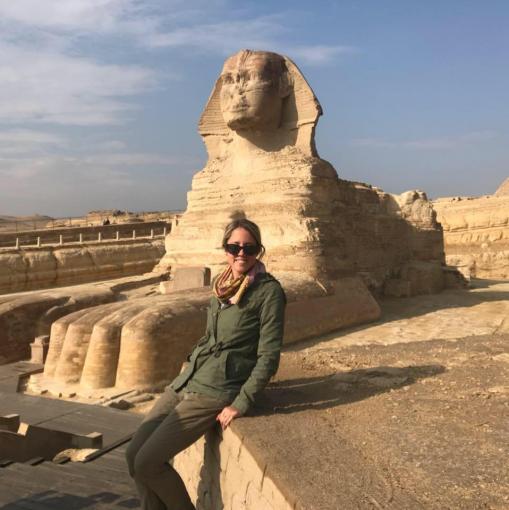I completed my research trip to Giza (Egypt) on April 5, 2019. As a collaborator of the Giza Plateau Mapping Project (GPMP) and part of the Ancient Egypt Research Associates (AERA) 2019 team, I spent two months excavating, mapping, and recording archaeological material from the Menkaura Valley Temple (ca. 2500 BCE). This experience has been incredibly beneficial to me at different levels.
First, for my Ph.D. studies at the department of Egyptology and Assyriology I am writing a dissertation on sociolinguistic aspects in letters and administrative documents from the same time period as the archaeological sites in the Giza plateau. Three of the documents from my corpus of dissertation sources were uncovered a hundred years ago in the same temple that I have been excavating for the past two months. We believe that some of the findings of this season, and which will be published soon, might provide new insights into the content of these texts.
At a professional level, the possibility of adding to my textual sources archaeological and unpublished material is a great opportunity to broaden the empiricism and audience of my work. Furthermore, I was honored to be asked by Dr. Mark Lehner, the director of the project, to write and publish the 2019 report for this archaeological season. As a young scholar, collaborating in the academic and scientific outcome of one of the most important archaeological projects in Egypt right now is an opportunity that I never expected to happen that early in my career.

Second, this has been my first archaeological experience in Egypt, and therefore, it has helped me enormously to attain professional skills which will be of great value for my future in the academic world, and may even lead to the directing of my own project in Egypt one day. I learned to properly register archaeological features following the very meticulous Museum of London Archaeology methodology, take above the sea level elevations, drawing and mapping archaeological sites, and making 3D models.
Finally, and at a more personal level, on February 7th 2019 I arrived in Egypt for the first time, after an entire life of reading, researching, and learning about ancient Egypt. I have to quote my supervisor, Prof. James P. Allen, in that an Egyptologist needs to see Egypt in order to understand it. Modern Egypt is an intersection of Islamic, African, and Pharaonic culture, while ancient Egypt was at the crossroads of the Semitic and the Kushite worlds. I believe that the African component of Egypt is often neglected in the western vision of both modern and ancient Egypt, but it was especially clear to me as I was traveling down the roads and villages between Giza and Saqqara, Dahshur, Ilahun and Meidum. During my daily interactions with Egyptians I was delighted by their affectionate, humble and helpful manners which are an exact reproduction of the hospitable nature of Egyptians in ancient texts. As a person who works on social factors that affect language, I surprised myself finding the same formulae of polite and hierarchical linguistic exchange in conversations that I analyze in letters for my dissertation.
This has been a unique experience that has shaped my career and perceptions not only of ancient Egypt, but also the Middle East. I am therefore extremely grateful to the Middle East Studies Award for enabling this trip which has been a crucial milestone in my life.